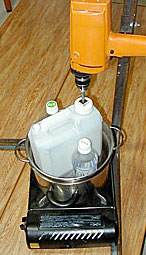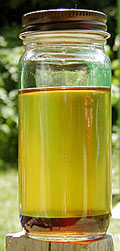Biodiesel seeks power at pumpMonterey County Herald - Monterey,CA,USA
... Morse is one of a growing number of regular customers who purchase biodiesel at Alliance Mart on Fremont Street in Monterey, the county's first and only retail ...Click Here to Make $20-$75/Hour for Your OpinionMonterey is a long way to go to fuel up for Prunedale's Cyrus Morse. But he thinks it's worth it.
Morse is one of a growing number of regular customers who purchase biodiesel at Alliance Mart on Fremont Street in Monterey, the county's first and only retail location for the alternative fuel. While it helps that Morse regularly commutes to Monterey for his job as a general contractor, fueling up at Alliance Mart is still out of his way. He must pay $3.40 a gallon to fill the tank in his 1991 Ford F250 truck, which he uses for work, rather than $2.97 a gallon for the petroleum-based diesel the station also sells.
But for Morse, the benefits of using a cleaner-burning, low-emission fuel, which is a blend of recycled vegetable oil and conventional petroleum-based diesel, outweigh the extra cost and minor inconvenience.
For him, it's about participating in a long-term strategy for reducing reliance on oil -- foreign, Alaskan or otherwise -- as well as cutting air pollution and global warming.
Besides, he said, his truck now gives off a pleasant aroma similar to corn oil or french fries, instead of the heavier petroleum-based odor associated with conventional diesel.
"The real reason (for using biodiesel) is trying to develop and promote an alternative fuel as a real option," Morse said. "The more I can contribute to an alternative fuel source's development -- for me, it's biodiesel -- the better."
Morse said he hopes that by supporting a local biodiesel retailer, he will encourage more people to start using alternative fuels and eventually create increased demand that will reduce the price.
"I'm hoping there will be a trickle-down effect," he said.
Morse's attitude about alternative fuel is echoed by most of the biodiesel customers at Alliance Mart, who have formed a tight-knit support group, said Jon Bohlman of the station's Salinas-based parent company, Toro Petroleum Corp.
It was Bohlman, Toro's fuel sales and distribution manager and the son of one of the company's founders, who drove the firm to add biodiesel to its list of products three years ago.
Toro does about $80 million in business annually supplying bulk fuels -- including gasoline and diesel, oils and lubricants to farmers, gas stations, contractors, automotive repair shops and other commercial businesses on the Central Coast, as well as in Arizona and Nevada.
Toro owns and operates several retail and commercial service stations in Monterey County, including Alliance Mart in Monterey.
Bohlman said Toro's other sales essentially subsidize its biodiesel business, which started slow but has expanded recently.
"This has really been a test for us," Bohlman said. "I liked the whole thought of a renewable fuel. We want to support alternative fuels and renewable fuels, and this was an easy way to do it. We're hoping in the future we'll see a greater demand for it. Our theory is that biodiesel sales will grow over time."
Development of alternative fuel technology has slowly been working its way into the mainstream consciousness.
California's Proposition 87 would impose a tax of up to 6 percent on oil produced in the state to pay for up to $4 billion in alternative energy vehicles, fueling stations, research, education and training.
But alternative fuel is not readily available, nor is the market particularly lucrative.
Bohlman started Toro's biodiesel business by selling the B99 blend -- it's 99 percent vegetable oil and 1 percent petroleum-based diesel -- to commercial and retail customers out of a 1,000-gallon tank at Alliance Mart that used to contain kerosene, as well as a 2,000-gallon storage tank in Salinas. Toro started out purchasing its biodiesel from a local consortium.
Business was initially so slow that Alliance averaged just a few customers per day. On some days, no one came in. The commercial side, which represents about 80 percent of the overall biodiesel sales, also took a while to build up. It took six to eight months to start making money, said Bohlman.
"We worked hard to make a profit," he said.
Three years later, Bohlman said, he sells about 13,000 gallons of biodiesel per year to a core of about 60 retail customers, many of whom come from as far away as Big Sur. He said the Fremont Street station averages about eight biodiesel customers per day.
Toro provides biodiesel to about a half-dozen commercial customers in Monterey and Santa Cruz counties out of its Gilroy bulk plant. Bohlman said Toro is negotiating with a garbage company to serve as its biodiesel provider.
Business has picked up so much that Toro is adding a 20,000-gallon storage tank in Gilroy earmarked for biodiesel. Toro has begun ordering most of its biodiesel from a larger provider, Las Vegas-based Nevada Biofuels.
One of Toro's commercial customers, Watsonville's Suncrest Nurseries Inc., uses biodiesel in all of its equipment, said Jim Marshall, vice president of operations.
The wholesale nursery, which has been using Toro's biodiesel since the fuel provider began offering it three years ago, uses B99 in its 30 tractors and a heavier blend, B20, in its fleet of delivery trucks.
Marshall said the Sept. 11, 2001 attacks motivated the business to focus on an alternative to petroleum-based products.
"We were all very affected by the attacks," he said. "We wanted to be part of the solution. And, we want to be part of a real green business. It's vastly better for the health of our workers. Biodiesel fits in nicely with our business philosophy."
Another of Toro's commercial customers is Pacific Grove's Greg Bean Auto, which purchases biodiesel for use in converting engines from conventional fuel to waste vegetable oil. Greg Bean Jr. said the auto shop has developed a special kit for engine conversions.
After being converted, vehicles feature two fuel tanks, one for biodiesel to start and warm up a vehicle, and one for waste vegetable oil to propel it.
Other retail biodiesel locations in the region include USA Grown Fuel in Santa Cruz, Mountain Feed and Farm Supply in Ben Lomond, and Western States Oil in San Jose.
--------------------------------------------------------------------------------
What is biodiesel? Biodiesel is a methanol or ethanol fuel made from the fat of vegetables or animals. It can be mixed with petroleum-based diesel and used in any diesel engine. Biodiesel is biodegradable and nontoxic, and can substantially reduce emissions of hydrocarbons and carbon monoxide. One study found carbon dioxide emissions were reduced by 78 percent compared to petroleum diesel.
Click Here to Make $20-$75/Hour for Your Opinion








